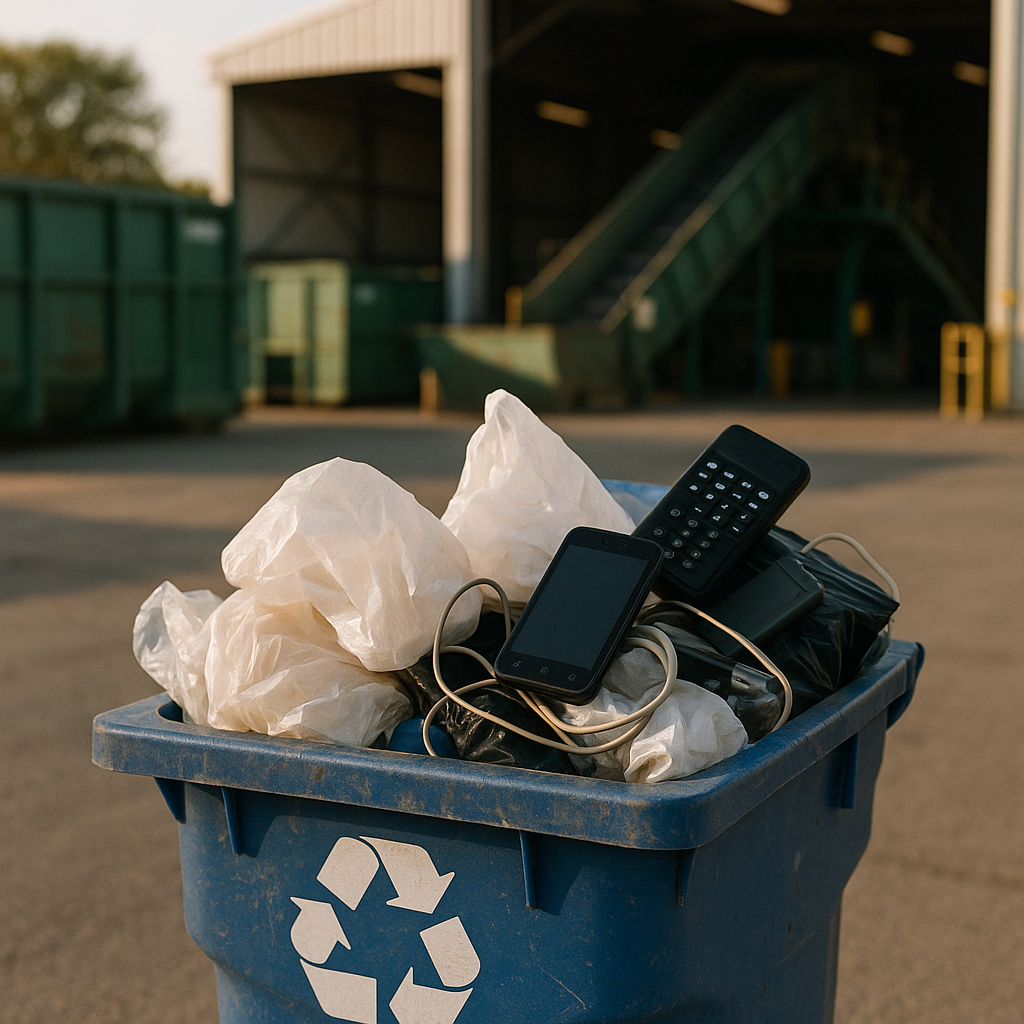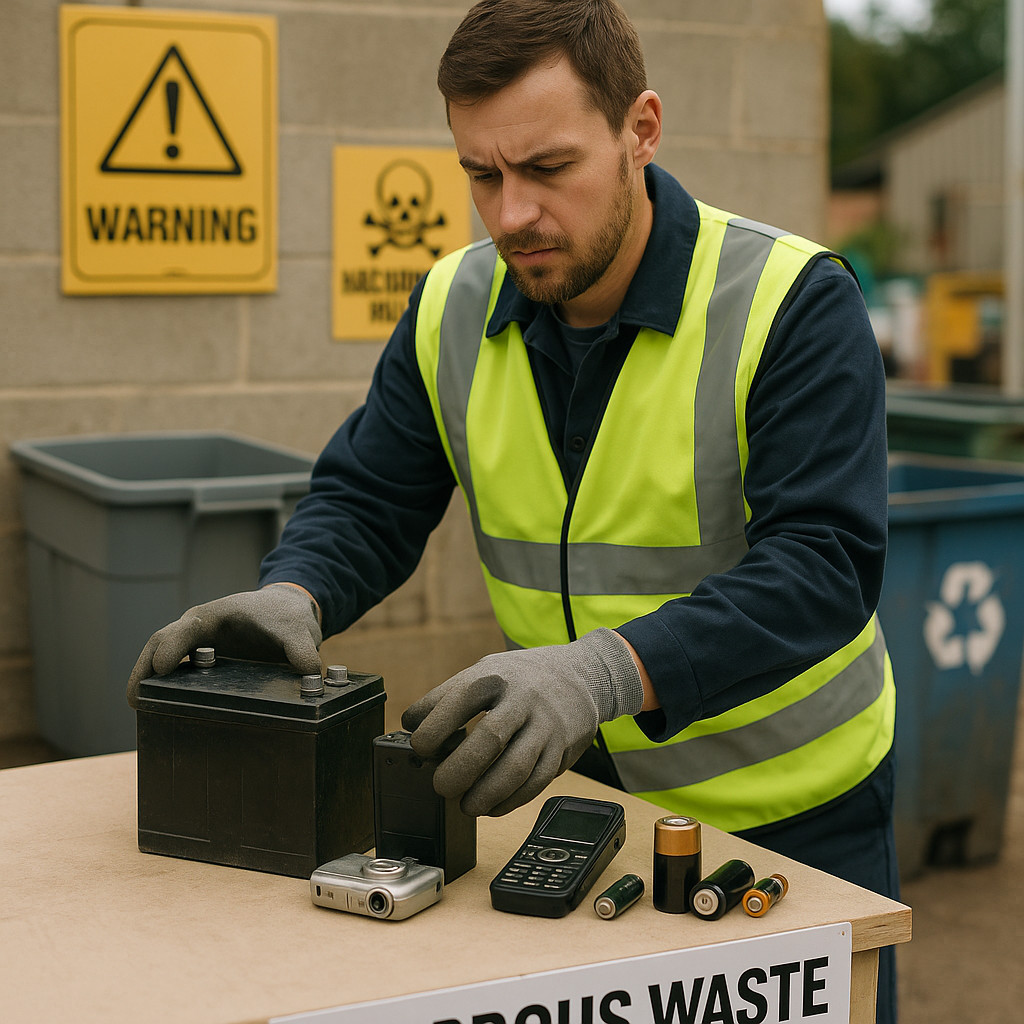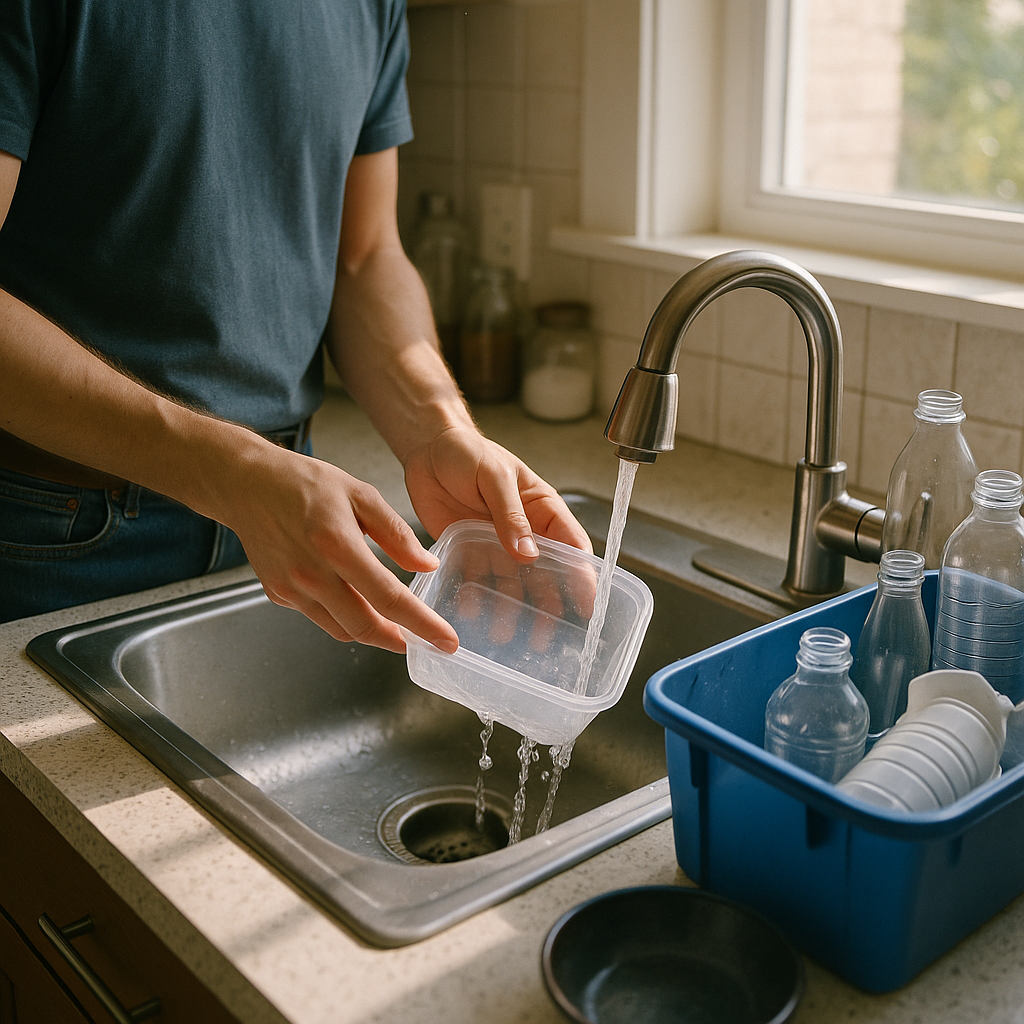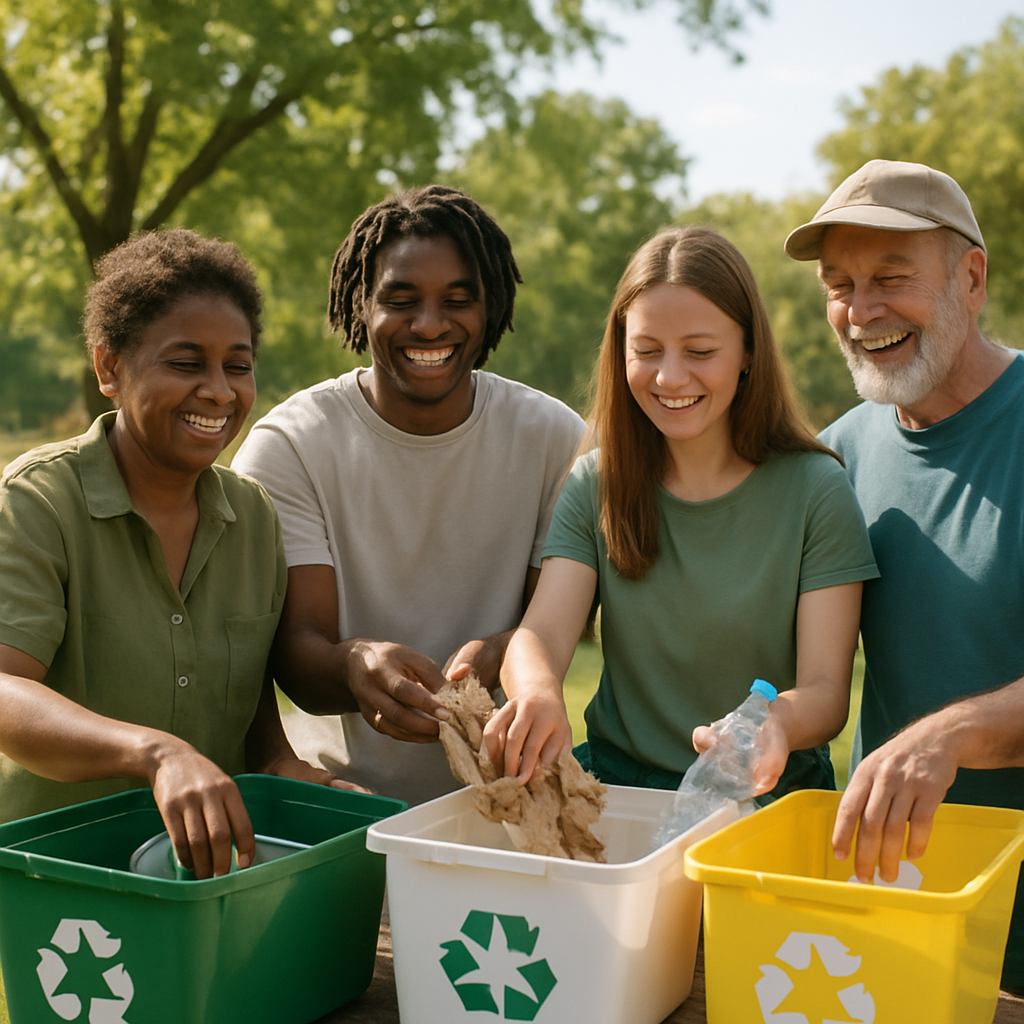5901 Botham Jean Blvd, Dallas, TX 75215
Most Common Items Not Accepted for Public Recycling
August 13, 2025Did you know a single contaminated item can send an entire batch of recyclables to the landfill? Despite good intentions, many households unwittingly place non-recyclable materials in their recycling bins. This contamination creates significant problems for recycling facilities and reduces overall recycling effectiveness.
Plastic bags and film top the list of problematic items. These materials tangle in sorting equipment, causing damage and operational delays. Electronics contain hazardous materials like lead and mercury that require specialized processing. Food residue and liquids contaminate otherwise recyclable materials, making them unusable. It’s just as important to know what doesn’t belong in your curbside bin as it is to understand what does.
Common items that should never go in your public recycling bin include plastic bags, plastic wrap, food waste, soiled packaging, garden hoses, wire hangers, disposable diapers, electronics, light bulbs, batteries, polystyrene foam, hazardous waste containers, textiles, and broken glass. While many of these materials can be recycled through specialty programs, they cause significant problems when mixed with standard recyclables.
Why are Plastic Bags and Films not Accepted in Public Recycling?

Plastic bags and films pose operational challenges for recycling facilities. These thin materials easily wrap around sorting machinery, causing system halts. Workers must manually remove the tangled plastic, leading to safety risks and costly downtime.
Material Recovery Facilities (MRFs) are not equipped to handle flexible plastics. While rigid containers like bottles and jugs move smoothly through sorting equipment, plastic bags bend and snag. A single grocery bag can jam a sorting line, decreasing productivity and increasing maintenance costs.
The physical properties of plastic film make it incompatible with standard recycling streams. Unlike heavier plastic containers easily sorted by optical scanners, bags and films are too light and flimsy for proper separation. Processing thin materials requires specialized equipment that most municipal recycling programs lack.
Contamination is another major issue. When plastic bags enter the recycling stream, they often contaminate other valuable recyclables. They can wrap around paper, cardboard, and other plastics, creating mixed materials that recyclers can’t easily separate, reducing the quality and value of recycled materials.
The economics also don’t work. The cost of collecting, sorting, and processing plastic film through standard recycling exceeds its market value. Recyclers need clean, separate material streams to produce profitable recycled products. Contamination by plastic bags reduces the value of entire batches.
Fortunately, alternative recycling options exist. Many grocery stores and retail locations offer collection programs specifically for plastic bags and film. These items are collected separately, kept clean and dry, and sent directly to specialized recyclers with the equipment to process them. Some films can even be recycled into products like outdoor decking and furniture.
For store drop-off programs to succeed, plastic films must be:
- Clean and dry with no food residue
- Free of stickers, labels, and receipts
- Separated from paper or cardboard
- Primarily polyethylene film (HDPE #2 or LDPE #4)
Crinkly plastic materials like chip bags and cereal box liners that tear easily are made from different types of plastic and typically aren’t recyclable through these programs. These should be disposed of with regular trash.
Understanding why plastic bags don’t belong in curbside recycling helps us make better disposal decisions. By keeping these materials out of recycling bins, we help ensure other recyclables are processed efficiently and maintain their value in the circular economy.
| Accepted at Retail Drop-off | Must Go in Trash |
|---|---|
| Plastic shopping bags (remove receipts) | Frozen food bags |
| Zipper-top plastic food storage bags | Cereal box liners that tear like paper |
| Bread bags | Biodegradable bags |
| Some plastic liners from cereal boxes | Pre-washed salad bags |
| Produce bags | Candy bar wrappers |
| Dry cleaning bags (remove staples) | Chip bags |
| Plastic newspaper wrapping | Six-pack rings |
| Product wrapping (e.g., water bottle case wraps) | |
| Bubble wrap and air pillows (popped) | |
| Plastic shipping envelopes (remove labeling) |
How Should Hazardous Materials and Electronics be Handled?

Hazardous materials and electronic waste require specialized handling procedures to prevent environmental contamination and ensure human safety. These items contain toxic substances that can leach into soil and water systems if improperly disposed of. Common household hazardous waste includes batteries, light bulbs, paint, chemicals, pesticides, and various electronic devices.
The key rule to remember is that hazardous waste should never be placed in standard recycling bins or regular trash. Different types of hazardous materials require disposal methods based on their chemical composition and potential environmental impact. For instance, batteries contain heavy metals like lead, cadmium, and mercury, that can contaminate groundwater if sent to landfills.
Electronic waste, or e-waste, presents its own set of challenges. Computers, smartphones, tablets, and other devices contain valuable resources like gold, silver, copper, and rare earth metals that can be recovered through proper recycling. The U.S. Geological Survey indicates that recycling one million laptops saves energy equivalent to the electricity used by more than 3,500 U.S. homes in a year.
Before recycling electronics, take these critical steps to protect your personal information:
- Delete all personal data from devices
- Perform a hard reset to return devices to factory settings
- Remove memory cards and SIM cards from devices
- Remove batteries, as they often need to be recycled separately
Communities offer several options for proper disposal of hazardous materials and electronics:
- Household hazardous waste collection events
- Permanent drop-off locations at recycling centers
- Manufacturer and retailer take-back programs
- Special mail-in recycling programs for items like batteries
Many electronics manufacturers and retailers have established recycling programs to help consumers dispose of unwanted devices responsibly. Resources like Earth911, Call2Recycle, and Greener Gadgets provide searchable databases where you can find local recycling options by entering your ZIP code.
For larger quantities of electronic waste, especially from businesses, it’s advisable to work with certified electronics recyclers. These facilities adhere to strict environmental standards and ensure proper handling of potentially hazardous components.
Cathode ray tube (CRT) televisions and monitors present special recycling challenges due to their lead content. Many second-hand stores no longer accept these items, so check with your local solid waste authority for specific disposal instructions.
The Environmental Protection Agency (EPA) regulates hazardous waste disposal through the Resource Conservation and Recovery Act (RCRA), which establishes the framework for proper management of these materials. Your local solid waste authority can provide guidance on specific disposal requirements in your area.
| Hazardous Item | Proper Disposal Method |
|---|---|
| Batteries | Recycling through special battery recycling programs or manufacturer take-back programs |
| Electronics | Recycle through certified electronics recyclers or manufacturer and retailer take-back programs |
| Paint and Chemicals | Household hazardous waste collection events or designated disposal centers |
| Gas Cylinders | Return to the manufacturer or handle through specialized hazardous waste programs |
Proper disposal of hazardous materials and electronics not only protects the environment but also supports the recovery of valuable resources, which can be used to manufacture new products, reducing the need for virgin materials and conserving natural resources.
What are the Guidelines for Recycling Food Containers and Packaging?

While many food containers are recyclable, they must be empty, clean, and dry. Soiled or wet materials contaminate other recyclables and can cause entire loads to be rejected. This contamination poses the biggest challenge to successful recycling programs nationwide.
The “spatula-clean” rule is a helpful guideline to follow. Containers should be scraped or rinsed to remove visible food residue; however, they don’t need to be spotless. Rinse containers using minimal water to remove food particles. For stubborn residue, a quick soak before scraping can be effective.
Different types of food containers require specific handling:
Plastic Containers
Most rigid plastic food containers that maintain their shape when bent are recyclable, including yogurt tubs, margarine containers, and deli packaging. Check the bottom for recycling symbols with numbers 1-7. Keep in mind that black plastic containers are often not recyclable because optical sorters at recycling facilities can’t detect them.
Food pouches, plastic film wrappers, and condiment packets generally aren’t recyclable through curbside programs. These flexible plastics can jam sorting machinery and contaminate other recyclables.
Glass Jars and Bottles
Glass food containers are infinitely recyclable but must be properly prepared. Empty jars completely and remove lids (which can be recycled separately). Labels can typically stay on, as they are removed during the recycling process. Avoid including broken glass, drinking glasses, or ceramics, as these have different melting points and can contaminate glass recycling.
Metal Food Containers
Aluminum and steel food containers are highly recyclable. This includes cans, pie pans, and clean aluminum foil. Make sure to rinse away food residue, particularly from pet food cans, which can attract pests at recycling facilities. Empty aerosol cans are recyclable in many areas but check your local guidelines first.
Food Cartons
Cartons for milk, soup, and juice are generally recyclable despite having a thin plastic lining. They should be emptied, rinsed, and dried before recycling. Do not recycle these with your mixed paper – they belong with plastic, metal, and glass recyclables.
If you are unsure about an item’s cleanliness or recyclability, it’s better to put it in the trash. Contaminated recyclables can ruin entire batches of otherwise recyclable materials. Check with your local recycling program for specific guidelines, as accepted materials can vary by location.
| Material Type | Recyclability | Preparation Guidelines | Notes |
|---|---|---|---|
| Plastic (Rigid) | Generally Recyclable | Rinse and remove food residue; check for recycling symbols #1-7; avoid excessive water use | Black plastic is often not recyclable as optical sorters can’t detect it |
| Plastic (Flexible) | Not typically recyclable curbside | Keep separate from curbside recycling; check for store drop-off options | Jams sorting machinery |
| Glass Jars and Bottles | Recyclable | Remove lids; labels can stay on | Avoid broken glass; don’t include drinking glasses or ceramics |
| Metal Cans | Recyclable | Rinse and remove food residue | Empty aerosol cans sometimes accepted; check local guidelines |
| Food Cartons | Recyclable | Empty, rinse, and dry | Do not recycle with mixed paper |
Conclusion: Recycling Right for a Sustainable Future

Proper recycling practices are essential for effective recycling systems and promoting environmental sustainability. Following recycling guidelines directly contributes to reducing contamination rates and improving the quality of recycled materials. This action helps preserve natural resources, decrease landfill waste, and minimize pollution.
The recycling journey doesn’t end when items leave our homes. By keeping problematic materials out of recycling bins, rinsing food containers, and learning about local recycling guidelines, we each play a crucial role in sustainability. Remember that a single contaminated item can render an entire batch of recyclables unusable. If you’re unsure about an item’s recyclability, contact your local recycling program or consider alternative disposal options. For your recycling needs, contact Okon Recycling at 214-717-4083.
